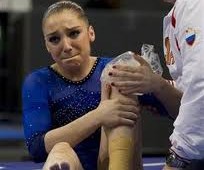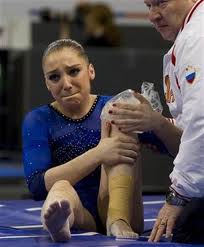The ABC’s of ACL Injuries in Gymnastics
Author: admin

Knee injuries can be fierce for a gymnast, and take a long time to recover.
 So many great gymnasts, men and women, have been effected by knee injuries that have caused them to lose parts or all of their season, such as Shawn Johnson, who tore hers while skiing in 2008, and Jason Gatson, who has had 2 ACL surgeries and was an icon in the sport for over 10 years.
So many great gymnasts, men and women, have been effected by knee injuries that have caused them to lose parts or all of their season, such as Shawn Johnson, who tore hers while skiing in 2008, and Jason Gatson, who has had 2 ACL surgeries and was an icon in the sport for over 10 years.
And then there is Justin Spring, who tore his while vaulting at Nationals in 2007, and then went on to have a wonderful showing at the Beijing 2008 Olympics. On our way to London in 2012, we have seen many of our national team members sustain knee injuries, and fight back from them… but not without incredible amounts of hard work and multi-disciplinary treatment. Because gymnastics is a weight bearing sport, it is really hard to “stay off” of your knee. With ligament injuries in the knee (most commonly either the MCL or ACL in gymnasts), if they tear, it is a 4-6 month surgical/recovery process.
There is not a large amount of information on ACL injuries specifically for gymnasts in the research and media, and even less on the return-to-sport advice-giving side.
What is the ACL and what does it do?
The Anterior Cruciate Ligament is a connection between the femur (thigh bone) and the tibia (shin bone). It is one of two ligaments (the other being the PCL or posterior cruciate ligament). The ACL prevents excessive or out of the normal range of motion of the knee, specifically the translation or forward slide of the tibia on the femur. Research states that women are more likely to injure theirs, and studies have looked into and cited many reason, among which are estrogen levels, wide hips or Q angle, and lower extremity muscle underdevelopment.
How is the ACL especially important in gymnastics?
The ACL provides stability to the knee in a very unstable environment. A gymnast needs to land in so many different ways: two footed, one footed, soft surfaces, hard surfaces, various manufacturers of equipment, trampolines, landing mats, spring floors, plyometric conditioning and more. The body, because of all of these different reaction surfaces, needs to get used to so many different situations, that Muscle Memory, or the body getting used to combinations of timing, muscle use, joint position on impact, ground reaction forces and more, can be lower because of so many situation options. As well, skills are learned when they are transitioned from lead-ups, or drills, to various matting, to actual hard surface completion. Throughout this process, “short” landings, or over-rotations, or under-rotations exist within the learning process, until the athlete perfects timing, air sense, and more. Gymnastics is unique in that the risk often to completion of skills is not in the performance upon attainment, but in the learning process itself. Lastly, the velocity, torque, and ground reaction forces are high. The sport often requires high speed flipping or rotation that is not slowed down in the air prior to impact with the ground, but instead, at the time of impact with the ground or matting. Therefore, if the alignment is not perfect, joints take forces that the ligaments are not intended to withstand.
How does a knee get an ACL injury?
Most of the time, the ACL injury is done with hyperextension of the knee or excessive torsion of the knee joint. In the sport of gymnastics, mechanisms of injury include but are not limited to:
- Landing flipping or twisting skills with legs straight because of a lack of air awareness, location of the floor when in the skill
- Landing short in piked or lay out based skills, such as vaults and skills like double back pikes on floor. The legs are straight in the air, and the ground is not properly anticipated.
- Twisting skills that are landed with the shoulders, hips, knees and toes not “squared” or in alignment with one another. The knee then gets torqued, taking most of the stress when the femur and tibia rotate in opposite directions, or one rotates on the other one. Rotational injuries are often accompanied by meniscus tears, and sometimes by a medial collateral ligament (MCL tear). This is known as the Terrible Triad.
- Lastly, it can be injured with the knees flexed and rotated at the same time. Most of the time, and rarely, this happens in high velocity situations like Arabian double front half outs, or handspring double front halves on vault, or toe front twisting dismounts off of bars.
Can someone who has an ACL injury ever return to activity and sports?
Athletes really should never be out of the gym at all with ACL injuries, except for the initial day or two after surgery. Otherwise, core exercises can be completed without risking injury to the leg. Arms and back can maintain strength, even when the athlete is on crutches if that is prescribed. Benchmarks have to be met in order to return completely. As the athlete progresses, they will increase their skills.
Rehabilitation factors vary based on age, level in gymnastics, access to proper therapy (distance, time, location, etc.) as well as commitment to rehabilitation from the athlete, parent/family (transportation, support, etc.), coaches, and peer support from teammates.
Best of luck to all people rehabilitating from ACL injuries. And kudos to all who are doing research and finding out how to prevent further injuries.
Source: To read the full article, please visit MedGym.net.
